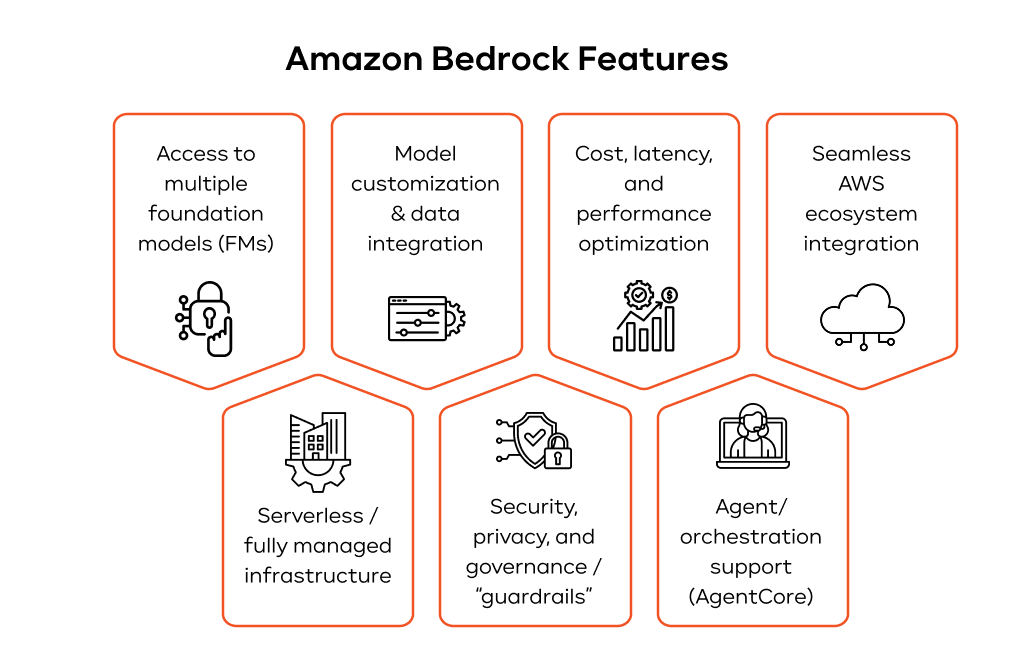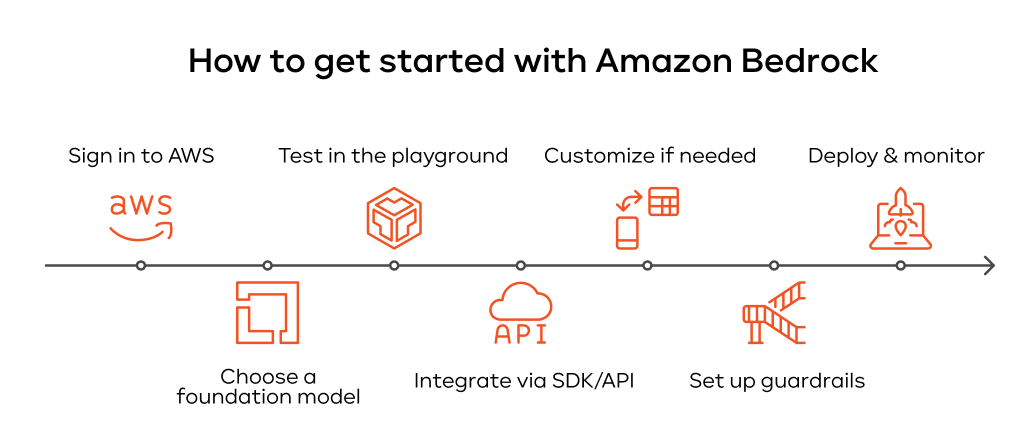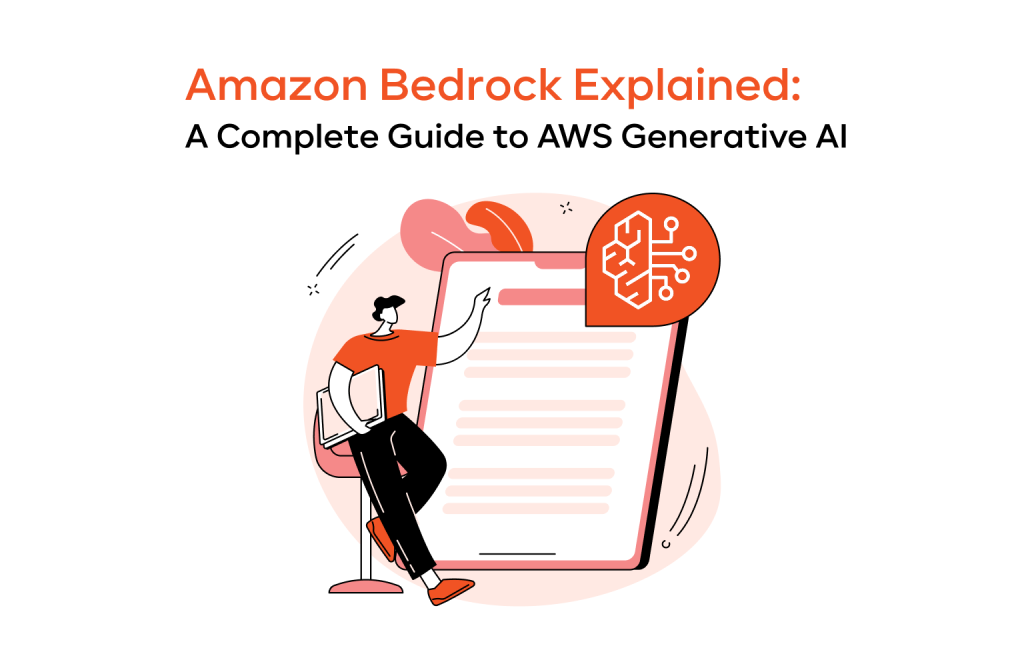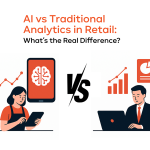Generative AI is changing how businesses create content, automate tasks, and deliver personal experiences. This new tech is a big deal. Amazon Web Services saw this coming and launched Amazon Bedrock. It’s a service made to simplify building and growing generative AI applications. But what is Amazon Bedrock in detail, and why should you care?
Simply put, Amazon Bedrock lets developers use top-notch AI models through one connection. You don’t have to worry about setting up or managing complex computer systems. This guide will show you what AWS Bedrock does and its main features. You’ll learn how companies are using it and how it compares to rivals like OpenAI and Google Vertex AI. If you’re looking to use the latest AI, this article will help you. You’ll see why Amazon Bedrock is becoming the best platform for safe, powerful, and ready-to-use business AI.
Why Amazon Bedrock matters in the GenAI landscape
Generative AI isn’t just a trend; it’s a huge shift set to become a multi-billion-dollar market. It’s growing fast because it can create content quickly, automate many jobs, and give customers super-personal experiences. But for many companies, getting into generative AI comes with big problems:
- Complicated setup:
Managing special computer hardware for large AI models takes a lot of effort and money.
- High training costs:
Building or adjusting FMs needs a lot of computing power and expert knowledge.
- Too many foundation models:
There are so many FMs out there that picking the right one for a specific job can feel impossible.
- Security & rules:
Making sure AI systems follow strict rules for privacy and data is super important.
- Scaling issues:
Moving an AI project from a small test to a big, working application is often tough.
Amazon Bedrock solves these problems. As it’s a fully managed service, it simplifies access to powerful foundation models. It handles all the underlying infrastructure. Plus, it works smoothly with other AWS services. This lets organizations do the following:
- Easily get access to a variety of FMs.
- Effortlessly grow generative AI applications.
- Use their existing AWS infrastructure seamlessly.
- Benefit from AWS’s strong security and rule-following framework.
By taking away the complex parts, Amazon Bedrock makes advanced AI available to everyone. It lets businesses innovate fast and safely, without heavy operational burdens.
How Amazon Bedrock works
Amazon Bedrock acts like a smart middleman between your apps and powerful generative AI foundation models. In simple terms, it gives you one connection point (an API) to use different FMs. You don’t need to manage the infrastructure for each model yourself.
- Foundation models (FMs): These are large, pre-trained AI models. They can do various tasks like writing text, creating images, or writing computer code. Amazon Bedrock gives you access to FMs from many different providers.
- API access: Your application sends a request (like asking for text to be written) to the Amazon Bedrock API. You tell it which FM to use. AWS Bedrock then sends this request, makes sure it runs, and sends back the result. This means you avoid setting up servers, updating software, or handling complex scaling.
Customization & integration:
- Fine-tuning: You can make FMs better by training them more with your own private data. This customizes their output to fit your specific area or brand voice.
- Retrieval-Augmented Generation (RAG): This is a key technique. It lets FMs create answers based on your company’s own information. Amazon Bedrock can find useful data from your knowledge bases (like files saved in S3). It then feeds this data to the FM. This makes answers more accurate and helps stop the AI from “hallucinations”.
- AWS ecosystem integration: Bedrock works perfectly with other AWS services. This can be S3 for storing data, Lambda for running code when certain things happen, and Step Functions for managing complex workflows.
So, what is AWS Bedrock? It’s an intelligent layer that simplifies FM access, manages infrastructure, and offers powerful customization tools. All of this happens within the trusted AWS environment.
Key features of Amazon Bedrock
Amazon Bedrock comes with many useful features built for serious, business-level generative AI.

Access to multiple leading foundation models
AWS Bedrock is like a “model playground.” It gives you access to FMs from top providers such as Amazon Titan (for text and embeddings), Anthropic Claude, AI21 Labs Jurassic-2, Cohere, Stability AI (Stable Diffusion for image generation), and Meta Llama 2. Having many different Amazon Bedrock AI models means you can pick the best one for your specific cases. You are not stuck with just one provider.
Fully managed environment without infrastructure overhead
AWS takes care of all the underlying infrastructure (GPUs, servers, scaling, updates, reliability). This lets developers focus only on building applications. It speeds up how quickly products get to market and greatly cuts down on operating costs.
Model customization and Retrieval-Augmented Generation (RAG)
Businesses can adjust FMs to their unique needs through:
- Fine-tuning/Adapters: Training models with their own special data. This makes their functionality and output more specific.
- RAG: Making model answers better by connecting them to internal knowledge bases. The “Knowledge Bases for Bedrock” tool makes it easy to create a database from your documents and feed it to FMs. This hugely improves accuracy and relevance.
Imagine a law firm using RAG with Amazon Bedrock. They can ask the AI to search their internal document library for old cases. The FM can then summarize legal rulings with much better accuracy because it has the right context.
_______________________________________________________________________
Want to use advanced generative AI and make it perfect for your specific cases?
Contact IT-Magic for expert advice and help with AWS Generative AI services.
_______________________________________________________________________
Built-in security, privacy, and compliance
Amazon Bedrock is built on AWS’s secure infrastructure. It follows global security rules (like GDPR, HIPAA). This is key for companies. Importantly, customer data used in Bedrock is not used to train the basic FMs. This keeps your data private and secret. Who can access what is managed by AWS IAM. Private connections are available through AWS PrivateLink.
Scalability and enterprise-level flexibility
AWS Bedrock is made to handle growth. It automatically adjusts computer resources to handle changes in demand. It supports setting up in multiple regions around the world for global reach and backup. It also offers top-level service agreements for businesses.
Integration with AWS ecosystem and agents for multi-step tasks
Amazon Bedrock works closely with services like S3, Lambda, and Step Functions. Its “Agents for Bedrock” functionality is especially powerful. It lets FMs do complex, multi-step tasks by breaking them down, planning actions, and talking to outside systems (like databases or other applications). This allows for automating tricky workflows that go beyond simple text generation.
Using Amazon Bedrock for AI applications
Amazon Bedrock is very flexible. It supports many different kinds of AI applications across diverse industries.
Content generation (text, images, marketing assets)
You can automatically create marketing words, blog posts, product descriptions, social media content, and image assets (using Stability AI models).
This makes content production faster, keeps brand style consistent, and helps create personalized content.
Imagine a marketing agency using Amazon Bedrock to create ads for different regions. They can change the tone and references using specific settings.
Virtual assistants and chatbots
It is possible to develop customer support bots, internal help assistants, and virtual agents that speak many languages (for example, using Anthropic Claude or Amazon Titan).
It improves customer experience, cuts down on operational costs, and helps employees do more.
For example, a large bank can use a Bedrock-powered chatbot to answer customer questions about bank services. This can cut down call center volume by 20%.
Business automation and task orchestration
You can automatically summarize legal documents, financial reports, sorts emails, and update supply chains. Agents for Bedrock can manage complex workflows.
This will make operations smoother, minimize human mistakes, and free up people for higher-value tasks.
Think that a manufacturing company can automate its entire order process, from the first question to delivery. This is possible with Bedrock agents working with AWS Step Functions.
Document analysis and summarization
You can find key ideas from contracts, research papers, and meeting notes; spot trends in large sets of documents.
Amazon Bedrock quickly processes vast amounts of unstructured data, helping with decisions and following rules.
Personalized recommendations
It is possible to create very specific product suggestions in online stores, content ideas for media platforms, and custom learning paths.
You will get users more involved, increase sales, and make customers happier.
AI-powered developer and DevOps assistance
With Amazon Bedrock, you can get AI assistants for writing and explaining code, automatically creating test cases, and smart analysis of system logs for fixing problems.
This boosts developer productivity, improves code quality, and speeds up how quickly software is built.
Getting started with Amazon Bedrock

Using Amazon Bedrock is designed to be user-friendly:
- Sign up for an AWS account: Create your free AWS account to use all services.
- Enable Amazon Bedrock: Turn on the Bedrock service in your AWS Console and ask for access to the foundation models you want.
- Choose a foundation model provider: Pick from models like Amazon Titan, Claude, or Stable Diffusion based on what your project needs.
- Run a simple API call: Try things out in the Bedrock “playgrounds” or use AWS SDKs (e.g., boto3 for Python) to send requests and get answers.
- Customize or fine-tune models: For special applications, fine-tune FMs with your own data (stored in S3). Or use RAG with Bedrock’s Knowledge Bases to make sure answers are based on your company’s information.
Integrate with other AWS services: Connect Bedrock with services like S3, Lambda, and Step Functions to build full AI applications.
_______________________________________________________________________
For detailed steps and code examples, check the official AWS Bedrock Documentation and explore our AWS Generative AI services.
_______________________________________________________________________
Advanced use cases and capabilities
Beyond common applications, Amazon Bedrock supports very advanced generative AI setups:
- Multi-agent orchestration:
Use several specialized agents that work together to solve hard problems. This creates more independent and smart systems.
- Industry-specific solutions:
Build custom AI for healthcare (e.g., patient navigation), finance (e.g., risk analysis), and legal (e.g., document review). This uses RAG with data specific to those industries.
- RAG with enterprise search tools:
Connect Bedrock with your existing company search platforms for even richer context. This leads to more exact FM answers.
- Combining Bedrock with SageMaker:
For advanced machine learning teams, use Bedrock for FM access along with Amazon SageMaker for deeper model customization, training, and setting up your own models.
Security and responsible AI in Bedrock
AWS puts a high priority on creating AI responsibly. Amazon Bedrock includes:
- Responsible AI framework: AWS’s approach focuses on fairness, understanding how AI makes decisions, privacy, and safety.
- Enterprise-grade compliance: It benefits from AWS’s strong security certifications, making it easier to use in regulated industries.
- Data isolation: What customers put in and get out is kept completely separate and not used to train the basic FMs. This keeps data private.
- Content filtering: It has tools to filter out harmful content generation.
This focus means Amazon Bedrock follows ethical AI rules. It lets businesses innovate responsibly.
Amazon Bedrock vs. other GenAI platforms
When looking at generative AI platforms, Amazon Bedrock stands out with its unique strengths:
| Feature | Amazon Bedrock | OpenAI API | Google Vertex AI | Azure OpenAI |
| Model Choice | Multi-model (Titan, Claude, Stable Diffusion, etc.) | Primarily OpenAI’s (GPT, DALL-E) | Google’s (PaLM, Gemini, Imagen) | OpenAI’s via Azure infrastructure |
| Integration | Deeply integrated with AWS ecosystem | API-first, requires external integration | Tightly integrated with Google Cloud ecosystem | Tightly integrated with Azure ecosystem |
| Managed Svc. | Fully managed, no infrastructure overhead | Managed API, but models run on OpenAI’s infra | Fully managed, Google Cloud native | Fully managed by Azure |
| Customization | Fine-tuning, Adapters, Knowledge Bases (RAG) | Fine-tuning, RAG (manual implementation) | Fine-tuning, RAG (Vertex AI Search) | Fine-tuning, RAG (Azure AI Search) |
| Target Audience | AWS-native enterprises, developers | Developers, researchers | Google Cloud-native enterprises, data scientists | Azure-native enterprises |
AWS Bedrock gives amazing flexibility with access to many different models and deep integration within the AWS ecosystem. This makes it perfect for organizations already using AWS. OpenAI is great with its main models for specific tasks. Google Vertex AI and Azure OpenAI are strong options for businesses that are already deeply connected to their respective cloud environments.
Best practices for Amazon Bedrock
To get the most value and efficiency from Amazon Bedrock, keep these tips in mind:
Cost optimization strategies
- Right-sizing:
Choose the correct model size and type for your task. This stops you from buying more than you need.
- Monitor usage:
Use AWS Cost Explorer and CloudWatch to track API calls and costs. This helps you find ways to save money.
- Batch processing:
For tasks that don’t need instant results, send requests in groups. This can often cut costs.
Monitoring and evaluating model performance
- Define KPIs:
Set clear goals (like accuracy, speed, cost per request, how relevant the answers are) for what your generative AI should produce.
- Automated & human-in-the-loop evaluation:
Use automatic checks for numbers, and have real people review the results for things that are more creative or subjective.
- CloudWatch & CloudTrail:
Use AWS tools to watch how often models are used and track who accesses the API.
Ensuring reliability and scalability
- Multi-region deployment:
Design your applications to run in several AWS regions. This helps with disaster recovery and keeps things running smoothly.
- Redundancy:
Build backup systems into your architectures. Use AWS services like SQS for message queues or Lambda for trying tasks again if they fail.
- Load testing:
Regularly test your Bedrock applications to make sure they can handle expected heavy use.
Conclusion
Amazon Bedrock is a key service in the generative AI landscape. It offers enterprises a secure, scalable, and flexible platform to build transformative AI applications. By simplifying access to leading foundation models, handling complex infrastructure management, and providing strong customization and integration options, Amazon Bedrock helps companies innovate faster and create new business value.
For CTOs and technical directors, Amazon Bedrock lowers the barriers to using generative AI. Teams focus on building smart solutions instead of managing complicated tech behind the scenes. As AWS continues to expand its generative AI offerings, Amazon Bedrock reinforces its position as a leading choice for businesses ready to harness the power of AI. See how AWS Bedrock can change your business AI projects.
Ready to transform your company with cutting-edge generative AI?
Contact IT-Magic for a personal chat and expert help. Leverage Amazon Bedrock to build your next-generation AI solutions.
FAQ
Who can benefit from Amazon Bedrock?
Amazon Bedrock helps many different users. These include enterprises, startups, developers, and data scientists across industries like retail, healthcare, finance, and media. All can benefit from building and scaling generative AI applications.
Does Amazon Bedrock require machine learning expertise?
No. While ML teams can fine-tune models for advanced needs, developers can largely use Amazon Bedrock’s APIs and pre-trained foundation models without deep ML knowledge. This makes generative AI much easier to access.
How is Amazon Bedrock different from OpenAI or Google Vertex AI?
AWS Bedrock offers a multi-model approach. It gives access to a wide range of FMs from different providers. It also deeply integrates within the AWS ecosystem. OpenAI focuses on its own models and is often chosen for specific, cutting-edge text and chat capabilities. Google Vertex AI offers Google’s FMs and works very closely with the Google Cloud ecosystem. This appeals to users already tied to Google Cloud.




